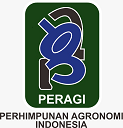Pengaruh Aplikasi Mikroba terhadap Fisiologis Beberapa Varietas Padi Fase Vegetatif pada Kondisi Salin Tergenang
Abstract
Padi merupakan makanan pokok di Indonesia yang produksinya harus ditingkatkan seiring bertambahnya jumlah penduduk. Lahan produktif beralih fungsi untuk kepentingan nonpertanian yang menyebabkan ketersediaan lahan untuk pertanian semakin sempit. Alternatif solusinya pemanfaatan lahan suboptimal (lahan salin menggenang). Tetapi, lahan ini dapat menghambat pertumbuhan dan produksi tanaman karena tingginya tekanan osmotik dan daya hantar listrik serta rendahnya ketersediaan oksigen yang dibutuhkan tanaman. Salah satu upayanya dengan aplikasi mikroba (pupuk hayati) dan varietas padi adaptif dan toleran. Pupuk hayati mampu memperbaiki kondisi salin menggenang dengan memfiksasi N, melarutkan fosfat dan kalium, memproduksi hormon pertumbuhan. Tujuan penelitian untuk mengetahui pengaruh mikroba terhadap aspek fisiologi beberapa varietas padi pada kondisi salin menggenang. Penelitian berlangsung mulai bulan September-Desember 2022. Perancangan percobaan menggunakan Rancangan Acak Kelompok dengan dua faktor, yaitu jenis konsorsium mikroba (tanpa mikroba/M0; konsorsium mikroba 1/M1; konsorsium mikroba 2/M2; konsorsium mikroba 3/M3), dan varietas padi (Pokkali/V1; Biosalin 2 Agritan/V2; IR 29/V3). Variabel pengamatan tinggi tanaman, jumlah anakan, klorofil (SPAD), jumlah stomata, klorofil a, klorofil b, prolin, enzim SOD, laju fotosintesis, konduktansi stomata, dan laju transpirasi. Data dianalisis dengan uji F, apabila berbeda nyata dilanjutkan dengan uji DMRT 5%. Hasil penelitian menunjukkan konsorsium mikroba berpengaruh sangat nyata terhadap kadar prolin, klorofil a, dan klorofil b, sedangkan varietas padi pada tinggi tanaman, jumlah stomata, dan laju transpirasi berpengaruh sangat nyata,namun tidak terdapat interaksi pada semua variabel pengamatan.
Keywords
Full Text:
PDFReferences
Agurla, S., Gahir, S., Munemasa, S., Murata, Y., & Raghavendra, A. S. (2018). Mechanism of Stomatal Closure in Plants Exposed to Drought and Cold Stress. In Survival Strategies in Extreme Cold and Desiccation (pp. 215–232). Springer Nature Singapore. https://doi.org/10.1007/978-981-13-1244-1
Al-Rabadi, G. J., Al-Dalain, S. A., Al-Rawashdeh, M. S., Al-Nawaiseh, M., Abdel-Ghani, A. H., Aldmour, R., Al-Abbsi, K., & Al-Nasir, F. (2019). Proline and agronomic production responses of different barley cultivars to salinity stress : A correlation analysis. Research on Crops, 20(3), 483–487.
https://doi.org/10.2991/iconhomecs-17.2018.55
Alhasnawi, A. N. (2019). Role of proline in plant stress tolerance : A mini review. Research on Crops, 20(1), 223–229. https://doi.org/10.31830/2348-7542.2019.032
Amuenda, J. A. A. (2015). Transpiration and water conduction. Plant Physiology Laboratory, 5, 1–5.
Ansari, R. A., Mahmood, I., Rizvi, R., Sumbul, A., & Safiuddin, S. (2017). Siderophores: Augmentation of Soil Health and Crop Productivity. In Probiotics in Agroecosystem (pp. 291–312). Springer Nature Singapore. https://doi.org/10.1007/978-981-10-4059-7
Ariadi, H., Fadjar, M., Mahmudi, M. (2019). The relationships between water quality parameters and the growth rate of white shrimp (Litopenaeus vannamei) in intensive ponds. Aquaculture, Aquarium, Conservation & Legislation, 12(6), 2103-2116.
Ariadi, H., Syakirin, M.B., Hidayati, S., Madusari, B.D., Soeprapto, H. (2022)a. Fluctuation Effect of Dissolved of TAN (Total Ammonia Nitrogen) on Diatom Abundance in Intensive Shrimp Culture Ponds. IOP Conference Series: Earth and Environmental Science, 1118(1), 012001.
Ariadi, H., Khristanto, A., Soeprapto, H., Kumalasari, D., Sihombing, J.L. (2022)b. Plankton and its potential utilization for climate resilient fish culture. AACL Bioflux, 15(4), 2041-2051.
Arifiani, F. N., Kurniasih, B., & Rogomulyo, R. (2018). Pengaruh Bahan Organik terhadap Pertumbuhan dan Hasil Padi (Oryza sativa L.) Tercekam Salinitas. Vegetalika, 7(3), 30–40. https://doi.org/10.22146/veg.38133
Aslam, M., Ahmad, K., Akhtar, M. A., & Maqbool, M. A. (2017). Salinity Stress in Crop Plants: Effects of stress, Tolerance Mechanisms and Breeding Strategies for Improvement. Journal of Agriculture and Basic Sciences, 2(1), 70–85.
Biswas, J. C., & Kalra, N. (2018). Effect of Waterlogging and Submergence on Crop Physiology and Growth of Different Crops and Its Remedies: Bangladesh Perspectives. Saudi Journal of Engineering and Technology (SJEAT), 3(6), 315–329. https://doi.org/10.21276/sjeat.2018.3.6.1
Carillo, P., Annunziata, M. G., Pontecorvo, G., Fuggi, A., & Woodrow, P. (2011). Salinity Stress and Salt Tolerance. In Abiotic Stress in Plants-Mechanisms and Adaptations (pp. 21–38). InTech.
Djajadi, D., Syaputra, R., Hidayati, S. N., & Khairiyah, Y. (2020). Effect of Vermicompost and Nitrogen on N, K, Na Uptakes and Growth of Sugarcane in Saline Soil. AGRIVITA Journal of Agricultural Science, 42(1), 110–119. https://doi.org/10.17503/agrivita.v41i0.2364
Dwipradnyana, I. M. M., Windia, W., & Sudarma, I. M. (2015). Faktor-faktor yang Mempengaruhi Konversi Lahan serta Dampaknya Terhadap Kesejahteraan Petani : Kasus di Subak Jadi, Kecamatan Kediri, Kabupaten Tabanan. Jurnal Manajemen Agribisnis, 3(1), 34–42.
Firdaus, R. B. R., Tan, M. L., Rahmat, S. R., & Gunaratne, M. S. (2020). Paddy, rice and food security in Malaysia: A review of climate change impacts. Cogent Social Sciences, 6(1), 1–17. https://doi.org/10.1080/23311886.2020.1818373
Gamalero, E., Bona, E., Todeschini, V., & Lingua, G. (2020). Saline and arid soils: Impact on bacteria, plants, and their interaction. Biology, 9(116), 1–26. https://doi.org/10.3390/biology9060116
Hadistian, H., Setiawan, C., & Munandar, A. (2021). Analisis Faktor-Faktor Konversi Lahan Pertanian di Kabupaten Tangerang dengan Menggunakan Geographically Weighted Regression. Majalah Geografi Indonesia, 35(2), 123–132. https://doi.org/10.22146/mgi.55226
Hailu, B., & Mehari, H. (2021). Impacts of Soil Salinity/Sodicity on Soil-Water Relations and Plant Growth in Dry Land Areas: A Review. Journal of Natural Sciences Research, 12(3), 1–10. https://doi.org/10.7176/JNSR/12-3-01
Handoyo, E. (2010). Konversi Lahan Pertanian ke Non Pertanian : Fungsi Ekologis Yang Terabaikan. Forum Ilmu Sosial, 37(2), 118–126. https://doi.org/10.15294/fis.v37i2.1514
He, H., Chen, Y., Li, X., Cheng, Y., Yang, C., & Zeng, G. (2016). Influence of salinity on microorganisms in activated sludge processes: A review. International Biodeterioration & Biodegradation, 119, 1–8. https://doi.org/10.1016/j.ibiod.2016.10.007
He, J., & Liang, Y.-K. (2018). Stomata. John Wiley & Sons. https://doi.org/10.1002/9780470015902.a0026526
Idris, A., Linatoc, A. C., & Bakar, M. F. B. A. (2019). Effect of Light Intensity on the Photosynthesis and Stomatal Density of Selected Plant Species of Gunung Ledang, Johor. Malaysian Applied Biology, 48(3), 133–140.
Karolinoerita, V., & Yusuf, W. A. (2020). Salinisasi Lahan dan Permasalahannya di Indonesia. Jurnal Sumberdaya Lahan, 14(2), 91–99. https://doi.org/10.21082/jsdl.v14n2.2020.91-99
Kasli, K., & Effendi, A. (2011). Pengaruh Tinggi Genangan terhadap Pertumbuhan Tanaman Padi Sawah ( Oryza sativa L.) dalam Pot. Jerami, 4(3), 206–212.
Kool, D., Agam, N., Lazarovitch, N., Heitman, J. L., Sauer, T. J., & Ben-gal, A. (2014). A Review of approaches for evapotranspiration partitioning. Agricultural and Forest Meteorology, 184, 56–70. https://doi.org/10.1016/j.agrformet.2013.09.003
Liu, C., Mao, B., Yuan, D., Chu, C., & Duan, M. (2022). Salt tolerance in rice: Physiological responses and molecular mechanisms. The Crop Journal, 10(1), 13–25. https://doi.org/10.1016/j.cj.2021.02.010
Machado, R. M. A., & Serralheiro, R. P. (2017). Soil Salinity: Effect on Vegetable Crop Growth. Management Practices to Prevent and Mitigate Soil Salinization. Horticulturae, 3(30), 1–13. https://doi.org/10.3390/horticulturae3020030
Makbul, Y., Limnakrisna, N., Wijaya, N., Ratnaningtyas, S., Dwiyantoro, P., & Cokrowitianto, A. (2021). The Effect of Toll Road Development on Agricultural Land Conversion in Indonesia: An Empirical Analysis. International Journal of Modern Agriculture, 10(1), 880–890.
Meihana, M., & Lakitan, B. (2022). Dampak Cekaman Muka Air Tanah Terhadap Morfologis, Anatomis dan Fisiologis Tanaman Buncis (Phaseolus vulgaris L.) di Fase Generatif. Jurnal Agroqua, 20(2), 280–291. https://doi.org/10.32663/ja.v%vi%i.3248
Mindari, W. (2009). Cekaman Garam dan Dampaknya Pada Kesuburan Tanah dan Pertumbuhan Tanaman. UPN “Veteran” Jawa Timur.
Mishra, M., Wungrampha, S., Kumar, G., Singla-Pareek, S. L., & Pareek, A. (2020). How do rice seedlings of landrace Pokkali survive in saline fields after transplantation? Physiology, biochemistry, and photosynthesis. Photosynthesis Research, 150(1–3), 117–135. https://doi.org/10.1007/s11120-020-00771-6
Mitiku, T., Biratu, W., & Yadesa, L. (2022). Genomic Mapping, Molecular Marker and Marker Assisted Selection in Rice: A Review. Agro Bali : Agricultural Journal, 5(3), 422–433. https://doi.org/10.37637/ab.v5i3.979
Mondal, M. M. A., Puteh, A. B., Malek, M. A., & Rafii, M. Y. (2013). Salinity induced morpho-physiological characters and yield attributes in rice genotypes. Journal of Food, Agriculture & Environment, 11(2), 610–614.
Murniati, A., Tahir, D., & Tahir, R. (2022). Identifikasi Mikroba Rizosfer Penghasil Hormon Pertumbuhan pada Tanaman Padi (Oryza sativa L.). Agro Bali : Agricultural Journal, 5(3), 608–615. https://doi.org/10.37637/ab.v5i3.1040
Nasrudin, N., & Isnaeni, S. (2022). Respons karakteristik agronomi, fisiologi, dan biokimia padi (Oryza sativa L.) tercekam salinitas dengan umur bibit berbeda. Agromix, 13(1), 118–125. https://doi.org/10.35891/agx.v13i1.2859
Nasrudin, N., Rosmala, A., & Wijoyo, R. B. (2022). Application of Silica Nutrients Improves Plant Growth and Biomass Production of Paddy under Saline Conditions. Caraka Tani: Journal of Sustainable Agriculture, 37(1), 111–122. https://doi.org/10.20961/carakatani.v37i1.43425
Nazirah, L., & Simahate, R. (2022). Karakteristik Agronomi Beberapa Jenis Padi (Oryza sativa L.) Lokal Aceh Akibat Pemberian Pupuk Nitrogen. Jurnal Agrium, 19(4), 392–398. https://doi.org/10.29103/agrium.v19i4.9744
Nmegbu, & Jacob, C. G. (2014). The Effect of Salt Concentration on Microbes during Microbial Enhanced Oil Recovery. International Journal of Engineering Research and Applications, 4(6), 244–247.
Novita, A., Mariana, M., Nora, S., Ramadhani, E., Julia, H., &
Lestami, A. (2022). Growth Characteristics of Vetiver Grass (Vetiveria zizanioides) on Saline Soils. Agro Bali : Agricultural Journal, 5(2), 365–368. https://doi.org/10.37637/ab.v5i2.933
Nurhaya, N., Syam, A., & Jafar, J. (2021). Stomata Density Analysis of Red Chili (Capsicum annuum L.) at Different Location. Agrotech Journal, 6(2), 87–94. https://doi.org/10.31327/atj.v6i2.1660
Okon, O. G. (2019). Effect of Salinity on Physiological Processes in Plants. In Microorganisms in Saline Environments: Strategies and Functions (pp. 237–262). Springer. https://doi.org/10.1007/978-3-030-18975-4_10
Pabuayon, I. C. M., Kitazumi, A., Cushman, K. R., Singh, R. K., Gregorio, G. B., Dhatt, B., Zabet-Moghaddam, M., Walia, H., & Reyes, B. G. de los. (2021). Novel and Transgressive Salinity Tolerance in Recombinant Inbred Lines of Rice Created by Physiological Coupling-Uncoupling and Network Rewiring Effects. Frontiers in Plant Science, 12, 1–22. https://doi.org/10.3389/fpls.2021.615277
Prihatin, R. B. (2015). Alih Fungsi Lahan di Perkotaan (Studi Kasus di Kota Bandung dan Yogyakarta). Aspirasi, 6(2), 105–118.
Prikhodko, I., Verbitsky, A., Vladimirov, S., & Safronova, T. (2020). Microflora microbiological characteristics of saline soils. E3S Web of Conferences 175, 09010, 1–9. https://doi.org/10.1051/e3sconf/202017509010
Purwaningrahayu, R. D. (2016). Karakter Morfofisiologi dan Agronomi Kedelai Toleran Salinitas. Iptek Tanaman Pangan, 11(1), 35–48.
Purwidiani, N., Afifah, C. A. N., Indrawati, V., Sutiadiningsih, A., & Wahyuningsih, U. (2018). Non-Rice Staple Food Patterns in Indonesia. Advances in Social Science, Education and Humanities Research (ASSEHR), 112, 241–244. https://doi.org/10.2991/iconhomecs-17.2018.55
Rachmawati, D., & Retnaningrum, E. (2013). Pengaruh Tinggi dan Lama Penggenangan Terhadap Pertumbuhan Padi Kultivar Sintanur dan Dinamika Populasi Rhizobakteri Pemfiksasi Nitrogen Non Simbiosis. Bionatura-Jurnal Ilmu-Ilmu Hayati Dan Fisik, 15(2), 117–125.
Rahayu, Y. S., Yuliani, Y., & Asri, M. T. (2021). Isolation and Identification of Endophytic Bacteria Related to Plant Nutrient Level in Coal Mining Site from East Kalimantan Indonesia. International Joint Conference on Science and Engineering, 209, 485–491. https://doi.org/10.2991/aer.k.211215.082
Rajanna, G. A., Dass, A., & Paramesha, V. (2018). Excess Water Stress: Effects on Crop and Soil, and Mitigation Strategies. Popular Kheti, 6(3), 48–53.
Rengasamy, P. (2006). World salinization with emphasis on Australia. Journal of Experimental Botany, 57(5), 1017–1023. https://doi.org/10.1093/jxb/erj108
Setiawati, M. R., Suryatmana, P., & Simarmata, T. (2020). Keragaman Mikroflora, Mikrofauna, Kandungan C-Organik, dan Total N Tanah Sawah Akibat Aplikasi Azolla dan Pupuk Hayati. Soilrens, 18(1), 41–49. https://doi.org/10.24198/soilrens.v18i1.29041
Shahriar-Tareq, M., Mamun, M. A. Al, Hossain, M. S., Higuchi, H., & Karim, M. A. (2021). Salinity Induced Changes in Growth and Physiology of Field Crops. Bangladesh Journal of Ecology, 3(1), 1–9.
Shrestha, J., Kandel, M., Subedi, S., & Shah, K. K. (2020). Role of Nutrients in Rice (Oriza sativa L.): A Review. Agrica, 9(1), 53–62. https://doi.org/10.5958/2394-448X.2020.00008.5
Shukla, J. B., Arora, M. S., Verma, M., Misra, A. K., & Takeuchi, Y. (2021). The Impact of Sea Level Rise Due to Global Warming on the Coastal Population Dynamics: A Modeling Study. Earth Systems and Environment, 2100. https://doi.org/10.1007/s41748-021-00246-1
Shultana, R., Zuan, A. T. K., Yusop, M. R., & Saud, H. M. (2020). Characterization of salt-tolerant plant growth-promoting rhizobacteria and the effect on growth and yield of saline-affected rice. PLoS ONE, 15(9), 1–16. https://doi.org/10.1371/journal.pone.0238537
Soeprapto, H., Ariadi, H., Badrudin, U. (2023). The dynamics of Chlorella spp. abundance and its relationship with water quality parameters in intensive shrimp ponds. Biodiversitas Journal of Biological Diversity, 24(5), 2919-2926. DOI https://doi.org/10.13057/biodiv/d240547
Solmaz, İ., Sari, N., Dasgan, Y., Aktas, H., Yetisir, H., & Unlu, H. (2011). The effect of salinity on stomata and leaf characteristics of dihaploid melon lines and their hybrids. Journal of Food, Agriculture & Environment, 9(3&4), 172–176.
Sopandie, D. (2014). Fisiologi Adaptasi Tanaman Terhadap Cekaman Abiotik Pada Agroekosistem Tropika. IPB Press.
Sujinah, S., Agustiani, N., & Rumanti, I. A. (2020). Daya Adaptasi Padi pada Kondisi Rendaman Stagnan. Penelitian Pertanian Tanaman Pangan, 4(1), 17–26. https://doi.org/10.21082/jpptp.v4n1.2020.p17-26
Sulaiman, A. A., Sulaeman, Y., & Minasny, B. (2019). A Framework for the Development of Wetland for Agricultural Use in Indonesia. Resources, 8(1), 1–16. https://doi.org/10.3390/resources8010034
Suryadi, M., Sumaryanto, S., Sumedi, S., Sukarman, S., & Rusastra, I. W. (2021). The agricultural land distribution and used on various agroecosystems in Indonesia. IOP Conference Series: Earth and Environmental Science, 1–8. https://doi.org/10.1088/1755-1315/892/1/012099
Susilowati, D. N., Sudiana, I. M., Mubarik, N. R., & Suwanto, A. (2015). Species and Functional Diversity of Rhizobacteria of Rice Plant in the Coastal Soils of Indonesia. Indonesian Journal of Agricultural Science, 16(1), 39–50.
Thaker, P. N., Brahmbatt, N., & Shah, K. (2021). A Review: Impact of Soil Salinity on Ecological, Agricultural and Socio-Economic Concerns. International Journal of Advanced Research, 9(07), 979–986. https://doi.org/10.21474/IJAR01/13200
Tiwari, S., Jain, M., Singla-pareek, S. L., Bhalla, P. L., Singh, M. B., & Pareek, A. (2023). Pokkali : A Naturally Evolved Salt-Tolerant Rice Shows a Distinguished Set of lncRNAs Possibly Contributing to the Tolerant Phenotype. International Journal of Molecular Sciences, 24, 1–18. https://doi.org/10.3390/ijms241411677
Ulkhaq, M. F., Budi, D. S., & Rahayu, N. N. (2020). The effect of temperature , salinity and antimicrobial agent on growth and viability of Aeromonas hydrophila. IOP Conference Series: Earth and Environmental Science, 1–5. https://doi.org/10.1088/1755-1315/441/1/012020
Wen-wen, Z., Chong, W., Rui, X. U. E., & Li-jie, W. (2019). Effects of salinity on the soil microbial community and soil fertility. Journal of Integrative Agriculture, 18(6), 1360–1368. https://doi.org/10.1016/S2095-3119(18)62077-5
Wu, D. H., Chen, C. T., Yang, M. Der, Wu, Y. C., Lin, C. Y., Lai, M. H., & Yang, C. Y. (2022). Controlling the lodging risk of rice based on a plant height dynamic model. Botanical Studies, 63(25), 1–12. https://doi.org/10.1186/s40529-022-00356-7
Wu, G., Liu, H., Hua, L., Luo, Q., Lin, Y., He, P., Feng, S., Liu, J., & Ye, Q. (2018). Differential Responses of Stomata and Photosynthesis to Elevated Temperature in Two Co-occurring Subtropical Forest Tree Species. Frontiers in Plant Science, 9(467), 1–8. https://doi.org/10.3389/fpls.2018.00467
Yan, K., Shao, H., Shao, C., Chen, P., Zhao, S., Brestic, M., & Chen, X. (2013). Physiological adaptive mechanisms of plants grown in saline soil and implications for sustainable saline agriculture in coastal zone. Acta Physiol Plant, 35, 2867–2878. https://doi.org/10.1007/s11738-013-1325-7
Yan, N., Marschner, P., Cao, W., Zuo, C., & Qin, W. (2015). Influence of salinity and water content on soil microorganisms. International Soil and Water Conservation Research, 3(4), 1–8. https://doi.org/10.1016/j.iswcr.2015.11.003
Yulina, N., Ezward, C., & Haitami, A. (2021). Karakter Tinggi Tanaman, Umur Panen, Jumlah Anakan dan Bobot Panen Pada 14 Genotipe Padi Lokal. Jurnal Agrosains Dan Teknologi, 6(1), 15–24. https://doi.org/10.24853/jat.6.1.15-24
Zameer, M., Zahid, H., Tabassum, B., Ali, Q., Nasir, I. A., Saleem, M., & Butt, S. J. (2016). PGPR Potentially Improve Growth of Tomato Plants in Salt-Stressed Environment. Turkish Journal of Agriculture - Food Science and Technology, 4(6), 455–463. https://doi.org/10.24925/turjaf.v4i6.455-463.614
Zhang, G., Bai, J., Zhai, Y., Jia, J., Zhao, Q., Wang, W., & Hu, X. (2023). Microbial diversity and functions in saline soils: A review from a biogeochemical perspective. Journal of Advanced Research, 1–12. https://doi.org/10.1016/j.jare.2023.06.015
Zhang, Y., Yu, C., Lin, J., Liu, J., Liu, B., Wang, J., Huang, A., Li, H., & Zhao, T. (2017). OsMPH1 regulates plant height and improves grain yield in rice. PLoS ONE, 12(7), 1–17. https://doi.org/10.1371/journal.pone0180825
Zhao, C., Zhang, H., Song, C., Zhu, J., & Shabala, S. (2020). Mechanisms of Plant Responses and Adaptation to Soil Salinity. The Innovation, 1(1), 100017. https://doi.org/10.1016/j.xinn.2020.100017
Refbacks
- There are currently no refbacks.



























